Michael Swanwick's Blog, page 73
September 2, 2019
Reading Tomorrow! NYC! With Exclamation Marks!
.
 I'll be reading from my new novel, The Iron Dragon's Mother, tomorrow at The Brtookly Commons. Also there to read from his work will be Gregory Feeley. Either one of us would be enough to make the evening worthwhile. (He said modestly.) So I see no reason for you not to attend.
I'll be reading from my new novel, The Iron Dragon's Mother, tomorrow at The Brtookly Commons. Also there to read from his work will be Gregory Feeley. Either one of us would be enough to make the evening worthwhile. (He said modestly.) So I see no reason for you not to attend.
Provided you live close by enough to do, that is.
Here are the deets:
September 3, 2019
7:00 p.m.
The Brooklyn Commons
388 Atlantic Avenue
Brooklyn, NY 11217
I look forward to seeing you there.
And in the ongoing series of plot diagrams . . .
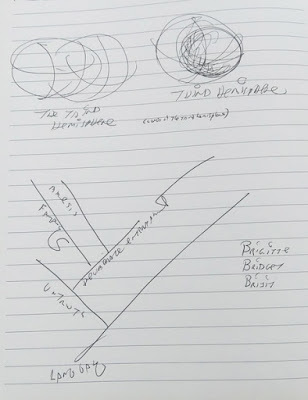
First of all, Faerie has three hemispheres. This is canonical. I was trying to visualize it at the top of the page.
On the bottom of the page, technically speaking, is a cladogram. Which means that I was feeling a bit puckish when I drew it. So I started with Language, from which derived Un-Truth, from which derived Deliberate Entertainment, which gave birth to Fantasy and Mimesis.
Some would disagree with my construction of the cladogram, of course. But they would be wrong.
*
 I'll be reading from my new novel, The Iron Dragon's Mother, tomorrow at The Brtookly Commons. Also there to read from his work will be Gregory Feeley. Either one of us would be enough to make the evening worthwhile. (He said modestly.) So I see no reason for you not to attend.
I'll be reading from my new novel, The Iron Dragon's Mother, tomorrow at The Brtookly Commons. Also there to read from his work will be Gregory Feeley. Either one of us would be enough to make the evening worthwhile. (He said modestly.) So I see no reason for you not to attend.Provided you live close by enough to do, that is.
Here are the deets:
September 3, 2019
7:00 p.m.
The Brooklyn Commons
388 Atlantic Avenue
Brooklyn, NY 11217
I look forward to seeing you there.
And in the ongoing series of plot diagrams . . .

First of all, Faerie has three hemispheres. This is canonical. I was trying to visualize it at the top of the page.
On the bottom of the page, technically speaking, is a cladogram. Which means that I was feeling a bit puckish when I drew it. So I started with Language, from which derived Un-Truth, from which derived Deliberate Entertainment, which gave birth to Fantasy and Mimesis.
Some would disagree with my construction of the cladogram, of course. But they would be wrong.
*
Published on September 02, 2019 09:02
September 1, 2019
Diagrams 3 and 4
.
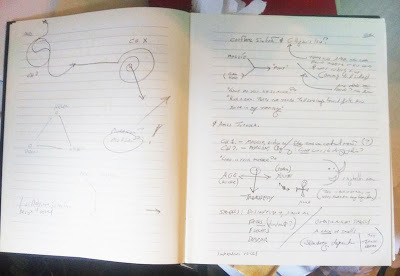
There are a lot of diagrams on the next two pages but I'll throw them out all at once because they were all drawn at the same time, trying to glimpse the same elusive white whale of a plot.
On the verso, a movement from yin-yang to spiral. A triangle establishing that briefly, Caitlin's name was Morgan. The same trite idea of combining Helen and Caitlin into a single entity. Also a reminder to re-read the Baltimore Catechism.
On the recto, I seem to have briefly renamed Helen Maggie. Another diagram opposing age and you, something (probably innocence) and treachery. A reminder to reread the great Amos Tutuola. Also, still caught up too enthusiastically in the notion of storytelling, are notes to conflate Sinbad and Gilligan's Isle, and a beginning to a fairy tale version of The Beverly Hillbillies:
There was a poor man who found treasure on his land and was suddenly rich.
Also an exchange between Caitlin and Helen (who, remember, was a TV producer) which I quite like, even though I didn't use it:
"Why do you lie so much?"
"Kick a rock. That's the truth. Tell somebody how it felt. Now you're in my territory."
And . . .
One more diagram, a short one and a rude one. It's titled Shortening the Way and below the stylized rocket takeoff is captioned The novel at its simplest. At this point, I was considering giving Helen and Caitlin different names, both beginning with the letter M. Terrible idea.
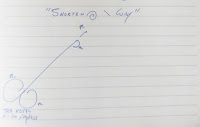
*

There are a lot of diagrams on the next two pages but I'll throw them out all at once because they were all drawn at the same time, trying to glimpse the same elusive white whale of a plot.
On the verso, a movement from yin-yang to spiral. A triangle establishing that briefly, Caitlin's name was Morgan. The same trite idea of combining Helen and Caitlin into a single entity. Also a reminder to re-read the Baltimore Catechism.
On the recto, I seem to have briefly renamed Helen Maggie. Another diagram opposing age and you, something (probably innocence) and treachery. A reminder to reread the great Amos Tutuola. Also, still caught up too enthusiastically in the notion of storytelling, are notes to conflate Sinbad and Gilligan's Isle, and a beginning to a fairy tale version of The Beverly Hillbillies:
There was a poor man who found treasure on his land and was suddenly rich.
Also an exchange between Caitlin and Helen (who, remember, was a TV producer) which I quite like, even though I didn't use it:
"Why do you lie so much?"
"Kick a rock. That's the truth. Tell somebody how it felt. Now you're in my territory."
And . . .
One more diagram, a short one and a rude one. It's titled Shortening the Way and below the stylized rocket takeoff is captioned The novel at its simplest. At this point, I was considering giving Helen and Caitlin different names, both beginning with the letter M. Terrible idea.

*
Published on September 01, 2019 00:30
Diagram 3
.

There are a lot of diagrams on the next two pages but I'll throw them out all at once because they were all drawn at the same time, trying to glimpse the same elusive white whale of a plot.
On the verso, a movement from yin-yang to spiral. A triangle establishing that briefly, Caitlin's name was Morgan. The same trite idea of combining Helen and Caitlin into a single entity. Also a reminder to re-read the Baltimore Catechism.
On the recto, I seem to have briefly renamed Helen Maggie. Another diagram opposing age and you, something (probably innocence) and treachery. A reminder to reread the great Amos Tutuola. Also, still caught up too enthusiastically in the notion of storytelling, are notes to conflate Sinbad and Gilligan's Isle, and a beginning to a fairy tale version of The Beverly Hillbillies:
There was a poor man who found treasure on his land and was suddenly rich.
Also an exchange between Caitlin and Helen (who, remember, was a TV producer) which I quite like, even though I didn't use it:
"Why do you lie so much?"
"Kick a rock. That's the truth. Tell somebody how it felt. Now you're in my territory."
*

There are a lot of diagrams on the next two pages but I'll throw them out all at once because they were all drawn at the same time, trying to glimpse the same elusive white whale of a plot.
On the verso, a movement from yin-yang to spiral. A triangle establishing that briefly, Caitlin's name was Morgan. The same trite idea of combining Helen and Caitlin into a single entity. Also a reminder to re-read the Baltimore Catechism.
On the recto, I seem to have briefly renamed Helen Maggie. Another diagram opposing age and you, something (probably innocence) and treachery. A reminder to reread the great Amos Tutuola. Also, still caught up too enthusiastically in the notion of storytelling, are notes to conflate Sinbad and Gilligan's Isle, and a beginning to a fairy tale version of The Beverly Hillbillies:
There was a poor man who found treasure on his land and was suddenly rich.
Also an exchange between Caitlin and Helen (who, remember, was a TV producer) which I quite like, even though I didn't use it:
"Why do you lie so much?"
"Kick a rock. That's the truth. Tell somebody how it felt. Now you're in my territory."
*
Published on September 01, 2019 00:30
August 31, 2019
Diagram 2
.

Here's the first overall diagram of the novel and it's amazing how unlike what The Iron Dragon's Mother eventually became my first thoughts of its structure are. I appear to have intended to blend Helen and Caitlin (then Charlotte) into single character.
Terrible, terrible idea.
Below the diagram I wrote:
This is the novel
At this point the young woman is or can be the storyteller
No, let the storyteller die
Also major deviations from what the book became. Yes, the nature of story is a big subtext and, yes, Caitlin must learn how to lie. But the idea of her becoming a storyteller is... let's say inappropriate.
*

Here's the first overall diagram of the novel and it's amazing how unlike what The Iron Dragon's Mother eventually became my first thoughts of its structure are. I appear to have intended to blend Helen and Caitlin (then Charlotte) into single character.
Terrible, terrible idea.
Below the diagram I wrote:
This is the novel
At this point the young woman is or can be the storyteller
No, let the storyteller die
Also major deviations from what the book became. Yes, the nature of story is a big subtext and, yes, Caitlin must learn how to lie. But the idea of her becoming a storyteller is... let's say inappropriate.
*
Published on August 31, 2019 09:30
August 30, 2019
Dragon Pilots
.
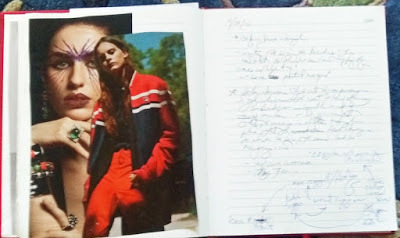
So what do dragon pilots look like? Tough, competent, dangerous. Pictured above are two pages from the second Prose Notebook for The Iron Dragon's Mother. The two young ladies are Sibyl and Ysault. You probably can't make out the text (and if you can, you probably can't make sense of my handwriting) but the picture was originally titled "Sibyl and Ashley." I gave all the dragon pilots Irish names, but that doesn't mean they're of Irish descent. It seems to be a convention among high-elven families for naming their female half-elven bastards.
There's a lot of plot that I decided not to use on that page, incidentally. Cat is invited to to join the Resistance. Helen interviews Sibyl out of compassion. And there's a reference to a "straggler with three packs of Marlboros." None of which made it into the novel.
Also, I worried a lot over what kind of swagger Ysault had.
And because some people like them . . .
Not everybody, but many people are fascinated by the use of diagrams to build a story. So at the bottom of these posts, I'm going to serialize the diagrams I drew in my Prose Notebooks to help see my way forward.
The first one covers the first chapter.
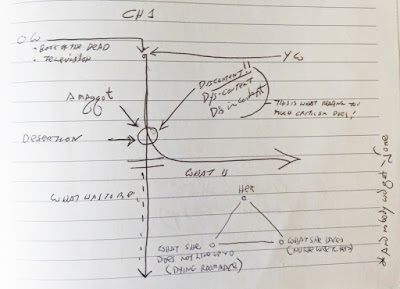
So far as I can tell, the only elements that remain of this diagram are the television and the Tibetan Book of the Dead. The triangle opposes "her" (Helen) with "what she doesn't live up to (dying roommate)" and "What she hates (Nurse Wretched)." The last is an obvious reference to Nurse Ratched in Ken Kesey's novel, One Flew Over the Cuckoo's Nest. Both were replaced by a trio of more recognizably human nurses.
I do like the fact that after the notations:
Discontent!!
Dys-content
Dis in context
I commented This is what reading too much criticism does!
*

So what do dragon pilots look like? Tough, competent, dangerous. Pictured above are two pages from the second Prose Notebook for The Iron Dragon's Mother. The two young ladies are Sibyl and Ysault. You probably can't make out the text (and if you can, you probably can't make sense of my handwriting) but the picture was originally titled "Sibyl and Ashley." I gave all the dragon pilots Irish names, but that doesn't mean they're of Irish descent. It seems to be a convention among high-elven families for naming their female half-elven bastards.
There's a lot of plot that I decided not to use on that page, incidentally. Cat is invited to to join the Resistance. Helen interviews Sibyl out of compassion. And there's a reference to a "straggler with three packs of Marlboros." None of which made it into the novel.
Also, I worried a lot over what kind of swagger Ysault had.
And because some people like them . . .
Not everybody, but many people are fascinated by the use of diagrams to build a story. So at the bottom of these posts, I'm going to serialize the diagrams I drew in my Prose Notebooks to help see my way forward.
The first one covers the first chapter.

So far as I can tell, the only elements that remain of this diagram are the television and the Tibetan Book of the Dead. The triangle opposes "her" (Helen) with "what she doesn't live up to (dying roommate)" and "What she hates (Nurse Wretched)." The last is an obvious reference to Nurse Ratched in Ken Kesey's novel, One Flew Over the Cuckoo's Nest. Both were replaced by a trio of more recognizably human nurses.
I do like the fact that after the notations:
Discontent!!
Dys-content
Dis in context
I commented This is what reading too much criticism does!
*
Published on August 30, 2019 06:19
August 29, 2019
Messenger
.

She is always mute because she is the voice of the Goddess.
As I never tire of boasting, the mere I have bubbling away on my laptop, the less I have to talk about. Today is a perfect example. I'm currently working on an interview and five introductions for projects I'm genuinely excited about. But I cannot yet talk about any of them.
Instead, I offer a page from my Prose Notebooks for The Iron Dragon's Mother. These are not the same as the Image Book. They're filled with my scribblings as I was writing the novel, many plot diagrams, workings-out of locales and the like. I'll be sharing a sampling of them in the coming month or so.
And an explanation . . .
Today's page is a rarity for me: a copy of someone else's work. The original is a painting by Jay DeFeo, a near-great artist who nearly destroyed her career by working obsessively on an enormous painting titled The Rose. You can look it up online but that's no substitute for standing in its presence. For one thing, it's ten and a half feet high. Also, it's massive. There are literally hundreds of pounds of paint on it, to the degree that it's more like a bas-relief than a flat painting. It has an astonishing presence. You could look at it for hours.
And eventually, you'll come to the conclusion that it's great but that it could be greater. That if DeFeo had changed it just a smidge it would be something even more wonderful.=. DeFeo came to this conclusion herself, which is why she spent years obsessively on the one single painting. It almost stopped her dead.
There's much more to her story and I encourage you to learn it.
Back to the Prose Notebooks, though. The sketch above is a crude copy of one of DeFeo's later (and considerably smaller) paintings It hit me hard when I saw it. This, I thought, is what the Voice of God looks like. And since so much of my work is about the Silence of God, it seemed inevitable that she would have a place in the novel.
The messenger never makes an overt appearance in The Iron Dragon's Mother. But she's never very far away.
*

She is always mute because she is the voice of the Goddess.
As I never tire of boasting, the mere I have bubbling away on my laptop, the less I have to talk about. Today is a perfect example. I'm currently working on an interview and five introductions for projects I'm genuinely excited about. But I cannot yet talk about any of them.
Instead, I offer a page from my Prose Notebooks for The Iron Dragon's Mother. These are not the same as the Image Book. They're filled with my scribblings as I was writing the novel, many plot diagrams, workings-out of locales and the like. I'll be sharing a sampling of them in the coming month or so.
And an explanation . . .
Today's page is a rarity for me: a copy of someone else's work. The original is a painting by Jay DeFeo, a near-great artist who nearly destroyed her career by working obsessively on an enormous painting titled The Rose. You can look it up online but that's no substitute for standing in its presence. For one thing, it's ten and a half feet high. Also, it's massive. There are literally hundreds of pounds of paint on it, to the degree that it's more like a bas-relief than a flat painting. It has an astonishing presence. You could look at it for hours.
And eventually, you'll come to the conclusion that it's great but that it could be greater. That if DeFeo had changed it just a smidge it would be something even more wonderful.=. DeFeo came to this conclusion herself, which is why she spent years obsessively on the one single painting. It almost stopped her dead.
There's much more to her story and I encourage you to learn it.
Back to the Prose Notebooks, though. The sketch above is a crude copy of one of DeFeo's later (and considerably smaller) paintings It hit me hard when I saw it. This, I thought, is what the Voice of God looks like. And since so much of my work is about the Silence of God, it seemed inevitable that she would have a place in the novel.
The messenger never makes an overt appearance in The Iron Dragon's Mother. But she's never very far away.
*
Published on August 29, 2019 07:32
August 28, 2019
Is There Something About Me Irish?
.
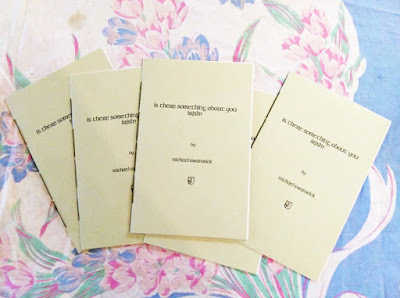
You wouldn't know it to look at my name, but I'm Irish to the bone. Or, rather, American Irish. There's a difference. That fact has been one of the great shapers of my personality.
To mark my third visit to Ireland, and so I'd have something to give away while at the Dublin Worldcon, I wrote six flash essays, all autobiographical, on that condition. Three are set in Ireland and three in the States. Marianne took these essays and made them into a chapbook, titled Is There Something About You Irish? To understand the title, I'm afraid you'll just have to read the chapbook.
As is usual with Marianne Porter's Dragonstairs Press, the chapbooks are lovingly made, hand-sewn, and seriously underpriced. They are signed and numbered in an edition of 60, of which 36 are available for sale. Eleven dollars domestic, twelve dollars overseas, postage included.
You can find the Dragonstairs Press site here.
Unusually for Marianne, there are two other publications yet available, though in small numbers. You can find them directly below the latest chapbook. Then you can wander down below them to see everything else that Dragonstairs has ever placed on sale, all of which have sold out.
And an apology . . .
For the two weeks I was in Ireland, I managed perhaps one blogpost. I apologize for that. Partly it was that I was busy. But mostly it was electronic technology and me... we just don't understand each other very well, I'm afraid.
But I'm home where everything is familiar and back on track. More blogposts on a more regular schedule are forthcoming.
Really. I mean it this time.
*

You wouldn't know it to look at my name, but I'm Irish to the bone. Or, rather, American Irish. There's a difference. That fact has been one of the great shapers of my personality.
To mark my third visit to Ireland, and so I'd have something to give away while at the Dublin Worldcon, I wrote six flash essays, all autobiographical, on that condition. Three are set in Ireland and three in the States. Marianne took these essays and made them into a chapbook, titled Is There Something About You Irish? To understand the title, I'm afraid you'll just have to read the chapbook.
As is usual with Marianne Porter's Dragonstairs Press, the chapbooks are lovingly made, hand-sewn, and seriously underpriced. They are signed and numbered in an edition of 60, of which 36 are available for sale. Eleven dollars domestic, twelve dollars overseas, postage included.
You can find the Dragonstairs Press site here.
Unusually for Marianne, there are two other publications yet available, though in small numbers. You can find them directly below the latest chapbook. Then you can wander down below them to see everything else that Dragonstairs has ever placed on sale, all of which have sold out.
And an apology . . .
For the two weeks I was in Ireland, I managed perhaps one blogpost. I apologize for that. Partly it was that I was busy. But mostly it was electronic technology and me... we just don't understand each other very well, I'm afraid.
But I'm home where everything is familiar and back on track. More blogposts on a more regular schedule are forthcoming.
Really. I mean it this time.
*
Published on August 28, 2019 07:32
August 27, 2019
"Ghost Ships" in F&SF
.
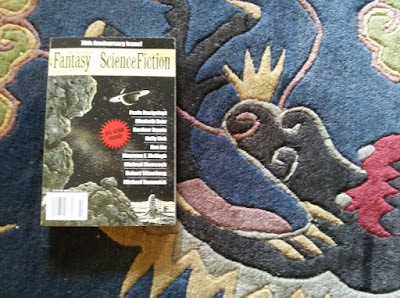
Look what came in the mail! The Dragonstairs Press rug is delighted.
The putting-together of a magazine issue is a delicate art. For the 70th anniversary of The Magazine of Fantasy and Science Fiction , obviously a lot of big names were required. But they also had to fit into a set number of pages. So it's possible for the editor and the publisher to like a story quite a lot but be unable to fit it in just because of its length.
Which is how I almost didn't make it into this particular issue. Long tale short, my story, "Ghost Ships" is the penultimate story in the issue. Gordon Van Gelder told me that he and C. C. Finlay both particularly wanted my story because it was about grief and mourning and they felt it belonged alongside Gardner Dozois' last story, "Homecoming," which is about the death of someone who isn't exactly a wizard but... well, I'm not going to spoil the story for you.
Given that between the time he sold the story to F&SF and the current issue, Gardner died, it's hard not to read this story as his farewell to us all. Placing it at the end of the issue was a graceful tribute to a man who always thought of F&SF as the single best SF magazine that wasn't edited by himself.
As for my story, here's what I wrote about it, as it was used in the introduction:
The magazine arrived yesterday and so far I've only read two stories--Gardner's and mine. But it has a stellar lineup and I'm confident that I'll enjoy every word of it.
And for those who like a peek behind the curtain...
During the process of selling the story, signing the contract, writing things to be used in the intro, proofing the galleys, etc., etc., it was revealed to me that my story might or might not make it into the 70th anniversary issue. In retrospect, I got something close to a running commentary: "The kid is barreling toward first. The outfielder scoops up the ball and throws! It's going to be close.! The kid slides! The first baseman has the ball and is reaching down for the tag! Aaaaand...."
Gordon showed me a copy of the issue at the Dublin Worldcon and apologized for "jerking me around." But the apology was unnecessary. I already had a story placed in one of F&SF's anniversary issues. Which is like winning a Hugo: Devoutly to be desired, but after the first one, the pressure is off. It's nice to win another award and it's very happy-making to be in another anniversary issue. But if I hadn't made it in, my heart wouldn't have been broken.
So, really, given the situation, I was the ideal person to be jerked around.
I'll be writing more about "Ghost Ships" elsewhere, sometime in the near future and when I do, I'll let you know where you can find it. I'm particularly proud of this story because it took enormous amounts of craft to write it and to make it work. And it says something. That's always desirable in fiction.
*

Look what came in the mail! The Dragonstairs Press rug is delighted.
The putting-together of a magazine issue is a delicate art. For the 70th anniversary of The Magazine of Fantasy and Science Fiction , obviously a lot of big names were required. But they also had to fit into a set number of pages. So it's possible for the editor and the publisher to like a story quite a lot but be unable to fit it in just because of its length.
Which is how I almost didn't make it into this particular issue. Long tale short, my story, "Ghost Ships" is the penultimate story in the issue. Gordon Van Gelder told me that he and C. C. Finlay both particularly wanted my story because it was about grief and mourning and they felt it belonged alongside Gardner Dozois' last story, "Homecoming," which is about the death of someone who isn't exactly a wizard but... well, I'm not going to spoil the story for you.
Given that between the time he sold the story to F&SF and the current issue, Gardner died, it's hard not to read this story as his farewell to us all. Placing it at the end of the issue was a graceful tribute to a man who always thought of F&SF as the single best SF magazine that wasn't edited by himself.
As for my story, here's what I wrote about it, as it was used in the introduction:
This work is in a long tradition of ghost stories where the author identifies himself as the protagonist and swears that every word is true. However, it breaks with the tradition in one way; every word of it is true. When my wife, Marianne Porter, read it for the first time, she said, "This is an essay." Which is factually correct, but I wrote it as if it were fiction. Only the names of the people involved were changed, for reasons which should be obvious.
The magazine arrived yesterday and so far I've only read two stories--Gardner's and mine. But it has a stellar lineup and I'm confident that I'll enjoy every word of it.
And for those who like a peek behind the curtain...
During the process of selling the story, signing the contract, writing things to be used in the intro, proofing the galleys, etc., etc., it was revealed to me that my story might or might not make it into the 70th anniversary issue. In retrospect, I got something close to a running commentary: "The kid is barreling toward first. The outfielder scoops up the ball and throws! It's going to be close.! The kid slides! The first baseman has the ball and is reaching down for the tag! Aaaaand...."
Gordon showed me a copy of the issue at the Dublin Worldcon and apologized for "jerking me around." But the apology was unnecessary. I already had a story placed in one of F&SF's anniversary issues. Which is like winning a Hugo: Devoutly to be desired, but after the first one, the pressure is off. It's nice to win another award and it's very happy-making to be in another anniversary issue. But if I hadn't made it in, my heart wouldn't have been broken.
So, really, given the situation, I was the ideal person to be jerked around.
I'll be writing more about "Ghost Ships" elsewhere, sometime in the near future and when I do, I'll let you know where you can find it. I'm particularly proud of this story because it took enormous amounts of craft to write it and to make it work. And it says something. That's always desirable in fiction.
*
Published on August 27, 2019 15:31
.Look what came in the mail! The Dragonstairs Press rug i...
.

Look what came in the mail! The Dragonstairs Press rug is delighted.
The putting-together of a magazine issue is a delicate art. For the 70th anniversary of The Magazine of Fantasy and Science Fiction , obviously a lot of big names were required. But they also had to fit into a set number of pages. So it's possible for the editor and the publisher to like a story quite a lot but be unable to fit it in just because of its length.
Which is how I almost didn't make it into this particular issue. Long tale short, my story, "Ghost Ships" is the penultimate story in the issue. Gordon Van Gelder told me that he and C. C. Finlay both particularly wanted my story because it was about grief and mourning and they felt it belonged alongside Gardner Dozois' last soty, "Homecoming," which is about the death of someone who isn't exactly a wizard but... well, I'm not going to spoil the story for you.
Given that between the time he sold the story to F&SF and the current issue, Gardner died, it's hard not to read this story as his farewell to us all. Placing it at the end of the issue was a graceful tribute to a man who always thought of F&SF as the single best SF magazine that wasn't edited by himself.
As for my story, here's what I wrote about it, as it was used in the introduction:
This work is in a long tradition of ghost stories where the author identifies himself as the protagonist and swears that every word is true. However, it breaks with the tradition in one way; every word of it is true. When my wife, Marianne Porter, read it for the first time, she said, "This is an essay." Which is factually correct, but I wrote it as if it were fiction. Only the names of the people involved were changed, for reasons which should be obvious.
The magazine arrived yesterday and so far I've only read two stories--Gardner's and mine. But it has a stellar lineup and I'm confident that I'll enjoy every word of it.
And for those who like a peek behind the curtain...
During the process of selling the story, signing the contract, writing things to be used in the intro, proofing the galleys, etc., etc., it was revealed to me that my story might or might not make it into the 70th anniversary issue. In retrospect, I got something close to a running commentary: "The kid is barreling toward first. The outfielder scoops up the ball and throws! It's going to be close.! The kid slides! The first baseman has the ball and is reaching down for the tag! Aaaaand...."
Gordon showed me a copy of the issue at the Dublin Worldcon and apologized for "jerking me around." But the apology was unnecessary. I already had a story placed in one of F&SF's anniversary issues. Which is like winning a Hugo: Devoutly to be desired, but after the first one, the pressure if off. It's nice to win another award and it's very happy-making to be in another anniversary issue. But if I hadn't made it in, my heart wouldn't have been broken.
So, really, given the situation, I was the ideal person to be jerked around.
I'll be writing more about "Ghost Ships" elsewhere, sometime in the near future and when I do, I'll let you know where you can find it. I'm particularly proud of this story because it took enormous amounts of craft to write it and to make it work. And it says something. That's always desirable in fiction.
*

Look what came in the mail! The Dragonstairs Press rug is delighted.
The putting-together of a magazine issue is a delicate art. For the 70th anniversary of The Magazine of Fantasy and Science Fiction , obviously a lot of big names were required. But they also had to fit into a set number of pages. So it's possible for the editor and the publisher to like a story quite a lot but be unable to fit it in just because of its length.
Which is how I almost didn't make it into this particular issue. Long tale short, my story, "Ghost Ships" is the penultimate story in the issue. Gordon Van Gelder told me that he and C. C. Finlay both particularly wanted my story because it was about grief and mourning and they felt it belonged alongside Gardner Dozois' last soty, "Homecoming," which is about the death of someone who isn't exactly a wizard but... well, I'm not going to spoil the story for you.
Given that between the time he sold the story to F&SF and the current issue, Gardner died, it's hard not to read this story as his farewell to us all. Placing it at the end of the issue was a graceful tribute to a man who always thought of F&SF as the single best SF magazine that wasn't edited by himself.
As for my story, here's what I wrote about it, as it was used in the introduction:
This work is in a long tradition of ghost stories where the author identifies himself as the protagonist and swears that every word is true. However, it breaks with the tradition in one way; every word of it is true. When my wife, Marianne Porter, read it for the first time, she said, "This is an essay." Which is factually correct, but I wrote it as if it were fiction. Only the names of the people involved were changed, for reasons which should be obvious.
The magazine arrived yesterday and so far I've only read two stories--Gardner's and mine. But it has a stellar lineup and I'm confident that I'll enjoy every word of it.
And for those who like a peek behind the curtain...
During the process of selling the story, signing the contract, writing things to be used in the intro, proofing the galleys, etc., etc., it was revealed to me that my story might or might not make it into the 70th anniversary issue. In retrospect, I got something close to a running commentary: "The kid is barreling toward first. The outfielder scoops up the ball and throws! It's going to be close.! The kid slides! The first baseman has the ball and is reaching down for the tag! Aaaaand...."
Gordon showed me a copy of the issue at the Dublin Worldcon and apologized for "jerking me around." But the apology was unnecessary. I already had a story placed in one of F&SF's anniversary issues. Which is like winning a Hugo: Devoutly to be desired, but after the first one, the pressure if off. It's nice to win another award and it's very happy-making to be in another anniversary issue. But if I hadn't made it in, my heart wouldn't have been broken.
So, really, given the situation, I was the ideal person to be jerked around.
I'll be writing more about "Ghost Ships" elsewhere, sometime in the near future and when I do, I'll let you know where you can find it. I'm particularly proud of this story because it took enormous amounts of craft to write it and to make it work. And it says something. That's always desirable in fiction.
*
Published on August 27, 2019 15:31
August 18, 2019
A Linguistic Footnote
.
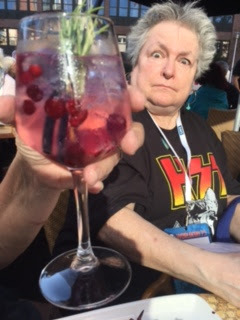
I was having dinner with The Fabulous Pat Cadigan last night (as well as other good friends) when Pat, reminiscing, almost settled a small mystery I've been wondering about for over 35 years: the origins of the word cyberpunk.
Gardner Dozois, who was often credited with inventing the word because he was the first to apply it to people like William Gibson in print (and who, when told another person claimed precedence, "Let him have the credit; it never did me any good!") always said that he'd first heard it in conversation. From Pat Cadigan, he thought.
So, as I said reminiscing, Pat told me that in 1979, she was either listening to the radio or watching TV (the restaurant was noisy), when Cars by Gary Numan came on. After the song, the DJ-or-VJ said, "Well, there's some cyberpunk for you."
Not long after, Pat carried the word into SF on foot... and the rest is rather well-documented.
The actual creator of the word may never be known. Unless it was on TV and somebody chances to stumble across the tape. And even then, who knows who the music jock himself got it from?
Language is a mysterious thing and endlessly wallowable-in.
Above: Pat, mugging for the camera in Helsinki.
*

I was having dinner with The Fabulous Pat Cadigan last night (as well as other good friends) when Pat, reminiscing, almost settled a small mystery I've been wondering about for over 35 years: the origins of the word cyberpunk.
Gardner Dozois, who was often credited with inventing the word because he was the first to apply it to people like William Gibson in print (and who, when told another person claimed precedence, "Let him have the credit; it never did me any good!") always said that he'd first heard it in conversation. From Pat Cadigan, he thought.
So, as I said reminiscing, Pat told me that in 1979, she was either listening to the radio or watching TV (the restaurant was noisy), when Cars by Gary Numan came on. After the song, the DJ-or-VJ said, "Well, there's some cyberpunk for you."
Not long after, Pat carried the word into SF on foot... and the rest is rather well-documented.
The actual creator of the word may never be known. Unless it was on TV and somebody chances to stumble across the tape. And even then, who knows who the music jock himself got it from?
Language is a mysterious thing and endlessly wallowable-in.
Above: Pat, mugging for the camera in Helsinki.
*
Published on August 18, 2019 00:49
Michael Swanwick's Blog
- Michael Swanwick's profile
- 546 followers
Michael Swanwick isn't a Goodreads Author
(yet),
but they
do have a blog,
so here are some recent posts imported from
their feed.



